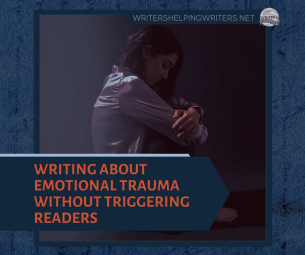Writing About Emotional Trauma Without Triggering Readers

Trigger warnings are often debated in the writing world. Some opine that readers should be warned if something potentially harmful is included in a book, and others feel the audience shouldn���t be bubble-wrapped and need to chin up if they want to read fiction. Like most things, the answer probably lies somewhere in the middle.
It can be easy to scoff away the idea of ���being triggered��� if one has never experienced damaging trauma, or if they have, they were able to process it in a healthy way. The reality is that dealing with emotional trauma is 100% personal. Even people experiencing the exact same event will cope with it differently based on their personality, age, support system, past experiences, education, and a host of other factors. So, assuming everyone should react the same way is ill-informed.
Where does this leave us, the authors? Ironically, in the same place had the trigger debate never occurred: we do our best to respect our readers, and use good judgment as we write.
No matter how dark and gritty our fiction is, we should never be gratuitous, meaning we should only show what we need to, not more. Genres will vary, but even if you���re writing a torture scene, there���s no need to slap every scream, sensation, and sweat drop onto the page. Overdone description will kill the pace and the impact will be lost under a wall of sensory words. Just like any other scene, our description should be balanced, pulling readers in without overwhelming them.
Here are a few ideas on how to handle potentially triggering content.
Use Symbolism and Mood to Seed HintsThe back jacket copy should indicate some of what will unfold in the story and perhaps even allude to trauma your character experienced in the past. But you will still need to show a scene (or several) that portrays these wounding experiences. If you���re worried about triggering, then don���t have this event slam into the reader out of nowhere. Lay a few clues so readers can put emotional safeguards up if they need to.

Mood, for example, is an excellent way to steer reader emotion. Weather, light and shadow, and universal symbolism can all help you nudge the reader toward the dark content about to be shown. Personal symbolism tied to the POV character can also lay the groundwork that something hurtful may be about to unfold: a sound, a smell, an object, a texture, a place that has specific meaning for the character. Including something that triggers their memory can help foreshadow something uncomfortable may be coming.
For example, if your character is about to be assaulted behind the restaurant where she works, take a moment to show her reluctance to take the garbage out. Maybe it���s because of the lack of alley lighting, or a memory surfaces of being surprised by a ranting homeless man who was digging in the trash another time she performed this chore. You could have her ease the door open and try and listen for hidden noises before venturing out to the bin. Or have an unpleasant odor hit her as she enters the dark. Symbolism and mood not only increase tension, they can give a subtle heads up that something significant is about to happen.
Deep POV is all the rage these days, but there are times when we shouldn���t use it. Don���t get me wrong, I���m not suggesting that emotionally difficult scenes should be reported rather than experienced from within the character���s shoes. I���m suggesting that you can pull readers in using deep POV to feel the intimate sensations and horror of the moment for a while and then zoom out to give them a break. A bit of filtering language (she thought, she smelled, he reached, he felt, it seemed, etc.) can achieve this as it adds distance. Or you could occasionally choose to name an emotion rather than show it in depth (NOTE: be careful with these techniques���always have a reason for using them or it will come across as lazy writing).
Weave In Facts (Telling) To Give a Break From ShowingShow, Don���t Tell implies ���all or nothing,��� but really this rule is meant to convey that writers should knowing WHAT to show (and when), and WHAT to tell. Deeply emotional scenes work best when there���s a good mix of show AND tell. Breaking up painful emotion and sensory detail with a few factual statements creates a balance, and if you need it to, will slide in a touch of distance so readers aren���t overwhelmed.
A good example of this is the Hunger Games, when Peeta and Katniss are on the Cornucopia as a fellow tribute is being torn apart by genetically engineered dogs. Susanne Collins doesn���t describe every gore spray and tear although she could have (the book states this goes on for over an hour, because of course the game makers are all about putting on a show). Describing such a horrific scene in full would be gratuitous and most people would stop reading. As someone attacked by a dog as a child and dragged around in the snow, helpless, I know I would have. But Collins handled it well, using narrative distance, selective show and tell, and information to get the horror across without overdoing it.
Only you can decide how close and personal you want to get with emotionally traumatic situations. It���s your story, your art. If you can justify to yourself what you need to show and why, you are respecting readers. It will feel authentic, not gratuitous, and they should respect your storytelling style in turn.
How to Show the Impact of a Wound
The Emotional Wound Database at One Stop for Writers contains over 120 types of trauma a character might have experienced, including abandonment, injustices, betrayals, hardships, failures & mistakes, childhood trauma and more.
If you need help, each entry guides you to better understand how a character’s behavior and personality may change in the aftermath of a specific trauma, the fears that can emerge, and how their view of themselves and the world shifts.
Examples from this database:
Being Stalked
Telling the Truth and Not Being Believed
Accidentally Killing Someone
More emotional wounds
The post Writing About Emotional Trauma Without Triggering Readers appeared first on WRITERS HELPING WRITERS��.
Writers Helping Writers
- Angela Ackerman's profile
- 1017 followers



